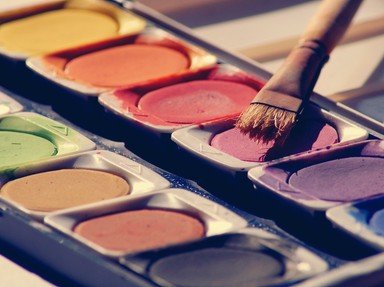Quiz Answer Key and Fun Facts
1. It is said that the pigment for this color originated in India during the 15th century. It was made from the urine of cows that were fed only mango leaves and water. The urine was collected, concentrated over a fire, and filtered through a cloth. Then the sediment was collected in balls and dried in the sun. It was shipped to Europe in ball form and was said to produce a very luminescent color that was especially vivid in sunshine. Which of these is being described?
2. Mummy brown is a pigment that makes a rich brown color, between burnt umber and raw umber. It was one of the favorite colors of the 16th and 17th centuries. Why do you suppose they called it "Mummy Brown"?
3. This pigment started out by digging lapis lazuli from the mines in Afghanistan. The pigment was transported over the silk road to Syria where it was loaded onto Arabian boats bound for Venice. It was then ground, mixed with linseed oil and heated to form a mixture that was kneaded like bread. Then it was placed in a lye solution to allow the desired flakes to separate, sink and dry, resulting in a fine powder pigment. The process was repeated to make the grains even finer. In the end you got the finest and most expensive version of this color used by Renaissance painters. It was so prized by them for the robes of the Virgin Mary that nothing else would be acceptable, despite the cost. What color was this known as?
4. This is said to be the oldest known natural pigment in the world. The cave paintings at Altamira and Lascaux used it. It was used by the Neanderthals over 200,000 years ago. What is it called?
5. In the early 1500s the Spanish began marketing a new pigment, a bright red called carmine that became wildly successful. It was used as a paint pigment, to dye cloth, and to make cosmetics. Europeans were desperate to know what this pigment was made of, but the Spanish weren't telling. They wanted to maintain their over-priced monopoly. For over 200 years they kept their secret until a young Frenchman managed to sneak into the area where the pigment was made. What did he discover that it was made from?
6. Cinnabar has been used for its color since antiquity. China used it for coloring lacquerware. The Olmecs in the South America used it in royal burial ceremonies. Europe used it to make vermilion color, a brilliant scarlet used in manuscripts and painting. The major source of the cinnabar pigment for all of Europe was the mines at Alamaden in Spain. But the dangers to the miners made it difficult for the administrators of the mines to find willing laborers, so they appealed to the government for condemned prisoners to work off their sentences in the mines. With 24% of these prisoners perishing before reaching their release date, it became necessary to begin importing slaves from Africa. The mines have since been closed, but what was it about the mining of cinnabar in this location that made it so hazardous?
7. This color was the most vibrant green available up until the 19th century. It was originally made by hanging copper plates over hot vinegar in sealed pots. Periodically the pots were opened and the crust on the plates was scraped off. In modern times I suppose you could just scrape it off the Statue of Liberty, but the New York Police Department would probably frown on it. What was this color called?
8. This color may have been first used by the Phoenicians. It was obtained by "milking" certain species of snails, which meant poking them and collecting the secretion that the snails emitted when they were attacked. Because of the time and labor required to collect and make the pigment, it was very expensive and could only by purchased by the very wealthy. Consequently it became associated with royalty. Which color is it?
9. Remove the sac from a cuttlefish (a relative of the octopus) before it gets a chance to deteriorate. Dry it and grind it to a fine powder. Mix it with shellac. This is an ancient recipe for what color of ink that has been in use since the days of the Greeks?
10. Orpiment is a mineral with an arsenic-sulfide compound found near volcanic areas. It was mentioned by Pliny and is found in Egyptian works. Once it is ground to a powder and mixed with a binder, what color do you suppose it yields?
Source: Author
OldManJack
This quiz was reviewed by FunTrivia editor
looney_tunes before going online.
Any errors found in FunTrivia content are routinely corrected through our feedback system.
